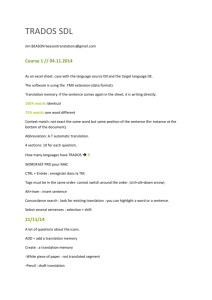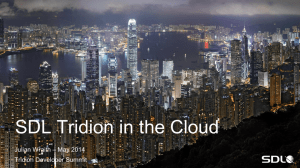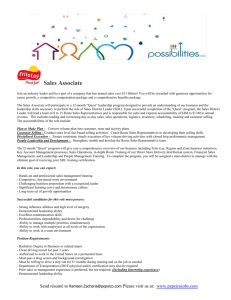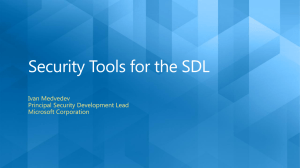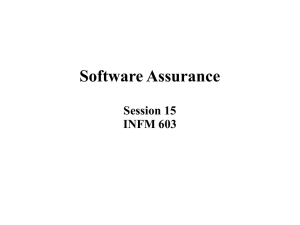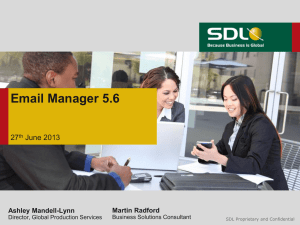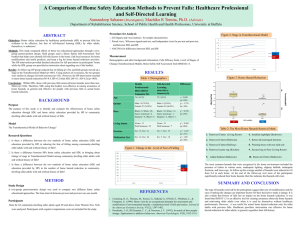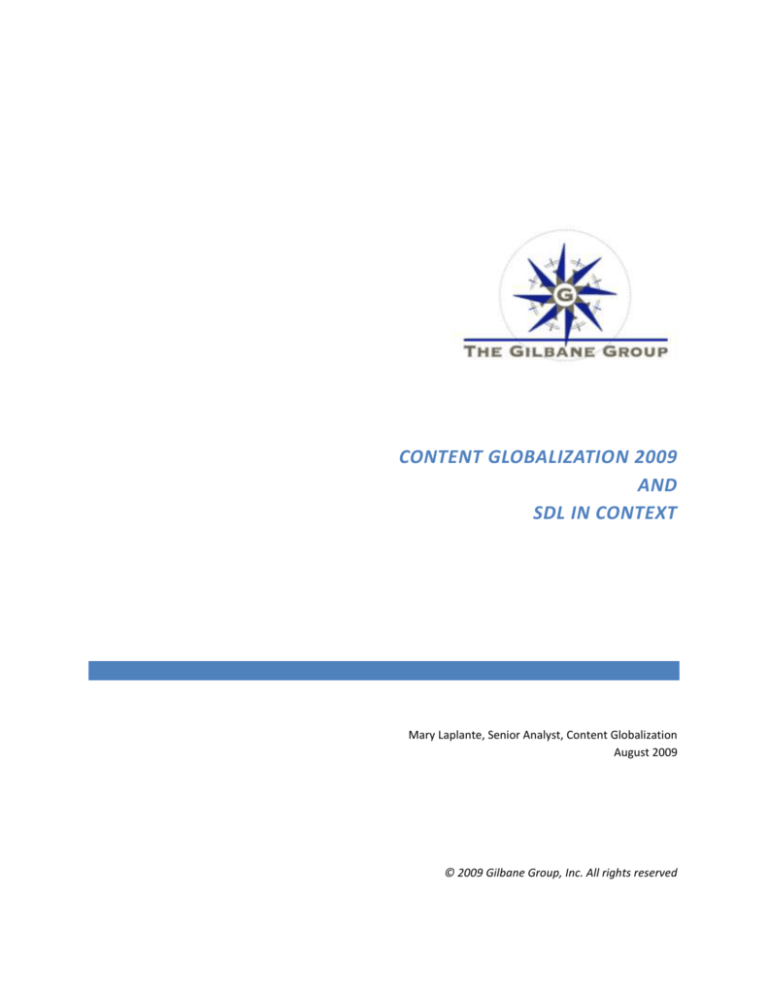
CONTENT GLOBALIZATION 2009
AND
SDL IN CONTEXT
Mary Laplante, Senior Analyst, Content Globalization
August 2009
© 2009 Gilbane Group, Inc. All rights reserved
CONTENT GLOBALIZATION 2009: STATE OF PRACTICE
In both principle and practice, it’s impossible to debate the value of delivering high-quality business
content in multiple languages. Content in the language of regional business drives revenue. Satisfies
customers. Builds and protects brand value. Ensures compliance with regulatory requirements. Enables
companies to maximize the value of global business opportunities.
Once organizations acknowledge the obvious value of multilingual content, they turn to the real work of
deploying solutions that enable them to actually realize that value. Gilbane’s research and field experience
consistently shows that industry-leading Global 2000 companies succeed when they align their
globalization practices with corporate business objectives. Without this conscious alignment and
continuous management of it, an organization will never fully
achieve a return on its investment in people, process, technology
and services that creates value for customers, partners,
“We implemented structured content
authoring, automated desktop
employees, and shareholders. With such alignment, the results
publishing, and interoperability with
are compelling:
our content management system,
translation technology, and services.
The result was a savings of over $900
per document and reduction of
translation time by five days.” –
Multilingual Communications as a
Business Imperative, Gilbane Group
Shorter time-to-market by moving localization and
translation processes further upstream.
Reduced translation costs by localizing once and using the
results in multiple deliverables and by sharing new and
existing language assets company-wide.
Faster time-to-global revenue, improved branding, and consistent translations across product lines by
managing terminology.
In our work documenting more than one hundred successes and failures, we have identified a set of
common global business enablers within organizations that successfully leverage their content as assets:
Content strategies are based on agility. Leading practitioners understand that content must be
readily available for use in any context, ideally without additional processes that negatively impact the
organization’s ability to respond to business opportunity quickly. To meet this requirement, content
cannot be dependent upon any one software application, hardware device, business use case,
audience, language, or even point in time (as is the case with product content, which in many cases
has a very long lifecycle).
Content strategies and practices are customer-centric. Leading practitioners are building customercentric globalization practices by focusing on the experience of the customer from the point of content
creation. Does the customer have the right product information in the right language when she is
ready to buy? Does a biotechnician have emergency operating instructions in his language available
on the medical device during a crisis? This emphasis marks a decided shift away from only
considering internal efficiencies and cost savings.
Content consistency is best practice. Leading practitioners view consistency as a dimension of quality
and have moved beyond wishing for consistency to actually achieving it. Positive customer experience
SDL in Context
Page 2
and strong brand management throughout all geographic territories and across all channels are at
high risk with it.
Content measurability is a priority. Leading practitioners are focused on gaining better, more
reliable insight into how global content impacts their operations, even though metrics are still
mysterious to many. The primary motivations are business cases for prioritizing investments and as
inputs into continuous improvements under the umbrella of governance.
Within organizations that enable their businesses with these practices,
Gilbane has also found a set of common capabilities and competencies
that distinguish them: ensuring quality at the point of source creation,
reusing content assets (source and translations) with a “write/translate
once, use many” model, sharing content and language assets within
and across departments, and reporting and monitoring asset use.
Furthermore, leading practitioners are automating and integrating the
technologies and services that deliver these capabilities, with the dual
goals of ensuring scalability to meet growing demand and driving costs
out of creating value through global content.
Leading content globalization
practitioners
Recognize value of content
as an enterprise asset.
Proactively manage content
as an asset.
Drive costs out of value
creation.
Scale processes to capitalize
on opportunities.
As for adoption, there’s clear evidence that companies aspire to content globalization practices
encompassing all of these approaches and capabilities, and that many organizations are making
significant progress towards integrated solutions for content globalization from authoring to delivery.
80% of departmental managers interviewed for a Gilbane study on multilingual business communications
believe in the concept of an integrated solution, and 92% believe there is “considerable” or “some” risk in
not improving the quality and efficiency of its components. It is the case, however, that few companies
have the resources to implement the full solution as a single investment or as part of a single program.
Multilingual communications initiatives tend to evolve organically, based on a particular pain point at
headquarters, within a department, or out in the field.
Regardless of how a company builds out its content globalization practice, top down or bottom up,
Gilbane sees SDL as well positioned to serve as an ideal partner for organizations that take action to align
their practices with strategic business objectives.
SDL IN CONTEXT OF MARKET REQUIREMENTS FOR CONTENT GLOBALIZATION
SDL is a market leader offering language translation services and technology-based solutions for global
authoring assistance, translation management (including translation memory and terminology
management), and content management. It holds a long-established position in its original services and
translation management markets, and it is aggressively expanding into new markets (such as content
management) through acquisition. As a result of its footprint and solid performance record, SDL is
virtually assured of making the short list of suppliers when global enterprises investigate options.
Companies seeking solutions will want to understand SDL’s qualifications, though, beyond its market
presence. How do SDL’s products and services line up with current and emerging content globalization
practices as described above?
SDL’s qualifications lie in 1) its comprehensive range of technologies and services, 2) its ability to deliver
domain-specific as well as integrated solutions, and 3) expertise that is both broad and deep.
SDL in Context
Page 3
SDL in Context
Page 4
TECHNOLOGIES AND SERVICES
With its range of offerings, SDL is uniquely positioned to help companies develop and deploy content
assets that are agile, customer-centric, consistent, and measurable. In addition, these enablers are
available throughout a content globalization practice, as SDL is the only vendor with breadth across
content creation, localization and translation, content management, and publishing (for technical and
commercial publishing, through SDL XySoft).
Technology Capability
Business Enabler Mechanism
Products
Agility Reuse, “write once/use many”
Technology-assisted
authoring/terminology
management
Localization/translation
management
Consistency Adherence to guidelines
SDL MultiTerm®
Agility Reuse, process and task
automation, integration
SDL Translation
Management System™
Consistency Centralized translation
memory, quality assurance
Measurability project tracking and
reporting
Agility Reuse, single-sourcing,
multichannel publishing, component
content management, multisite
management with web templates
Content management
Brand consistency
SDL Global Authoring
Management System™
Measurability Translation memory
reporting
Customer-centric Accurate, relevant
content in local language
Customer-centric Personalization and
customization enabled by component
content management and reuse
Consistency Single-sourcing
Business Value
Accelerated time-tomarket
Improved quality
Cost savings
SDL WorldServer™
SDL Trados Studio 2009®
SDL Passolo™
SDL Automated
Translation Solutions™
SDL Tridion R5™
SDL Trisoft™
SDL Contenta®
Improved customer
experience/loyalty
Cost savings
Efficiencies through
globalization
process integration
and automation
Revenue growth in
new global markets
Revenue growth in
new vertical
markets
Alignment with
product
development
Measurability Reuse reporting
The business enablers can also be delivered by SDL through its language services. The primary “product”
of a language service provider is multilingual content that is agile through reusability and consistent
through quality control and assurance. Metrics and measurability are typically contract requirements
between buyers and sellers of language services.
SDL in Context
Page 5
SOLUTION FLEXIBILITY
SDL’s acquisition strategy first consolidated its position as a provider of translation management systems,
then extended the company’s reach into adjacent functions such as content management. The company’s
integration of these components addresses the needs of buyers who come into the market seeking a
broader content globalization solution. Gilbane’s research indicates that integrated approaches are clearly
gaining momentum. Companies interviewed for our 2009 study on multilingual product content
identified a “global-ready technology architecture” as the second most-often cited ROI factor for
investment. The perception that the payoff lies in the establishment of a globalization-ready technology
architecture indicates that respondents understand that they need to evolve content infrastructures to
support corporate business goals. This result is quite significant—to our knowledge, it’s the first solid
evidence that globalization readiness is recognized as a worthy investment.
At the same time, SDL’s products for technology-assisted authoring, translation management, and
content management are solid, proven performers within specific functional domains. As an example,
SDL’s global content management products — SDL Tridion R5, SDL Trisoft, and SDL Contenta — are
market-leading solutions for web content management and component content management in their own
right. These and other domain-specific products in assisted authoring and translation management serve
the needs of buyers who need to solve a specific content globalization challenge today, then grow out from
there.
EXPERTISE
As a result of the range of its product line and the talent that SDL has grown and acquired over its
lifetime, the company has domain expertise in specific functional areas like translation management as
well as enterprise-level expertise in deploying integrated solutions. This expertise both broad and deep
positions the company as a partner, not a supplier.
We believe that this is an important distinction for buyers of technologies and services for content
globalization. In general, at certain levels of investment buyers tend to seek partners rather than
suppliers. Gilbane finds that this is especially true for critical practice areas such as content globalization;
in essence, companies are implementing an asset management system, as central to their businesses as
financial management systems or supply chain management. Companies are ill-served by partners and
suppliers who are not well-grounded in the applications, markets, and business problems of their clients.
MOVING TOWARDS ALIGNMENT
The path to alignment of content globalization practices with business objectives is not without
challenges, of course. Our research indicates that lack of collaboration across functional areas and
inconsistent terminology are among the most common organizational hurdles that companies have to
overcome as they build integrated, automated solutions. We note, however, that these problems can be
directly related to operational efficiencies that can be addressed with technologies available today.
SDL in Context
Page 6
This is, in fact, the case with nearly every perceived obstacle to improving and enhancing content
globalization practices. Although technology itself is one element of a solution – people and process are
also essential – products and services that can help companies overcome these obstacles are
Source: Multilingual Communications as a Business Imperative, Gilbane Group
readily available from SDL and other vendors. Inconsistent terminology and lack of collaboration, for
example, can be addressed with terminology management systems and workflow capabilities embedded
in content and translation management systems, respectively. The integration of content management
and translation management systems enables synchronization of content assets. Gilbane’s 2009 case
study on the integration at FICO is evidence that companies are indeed realizing business value today.
With its range of technologies and services, its ability to provide integrated as well as domain-specific
solutions, and extensive expertise, SDL is in a position to help companies deliver high-quality multilingual
content that is agile, customer-centric, consistent, and measurable –
the kind of content that creates true competitive advantage in a
Gilbane sources cited in this commentary
global economy.
ABOUT GILBANE GROUP
Innovation3: The FICO Formula for Agile
Global Expansion
Multilingual Product Content:
Gilbane Group is an analyst and consulting firm focused on content
Transforming Traditional Practices Into
technologies and their application to high-value business solutions.
Global Content Value Chains
We track developments and trends in the markets for technologies
Multilingual Business Communications as
that companies use to create, manage, deliver, and consume content.
a Business Imperative: Why Organizations
Our mission is to help organizations develop sustainable content
Need to Optimize Their Global Content
Value Chains
strategies, make smart buying decisions, and deploy content-centric
business solutions that deliver measurable value. Our newsletter,
research reports, case studies, white papers, and blogs are freely available at http://gilbane.com. Follow
us on Twitter at http://twitter.com/gilbane.
SDL in Context
Page 7

